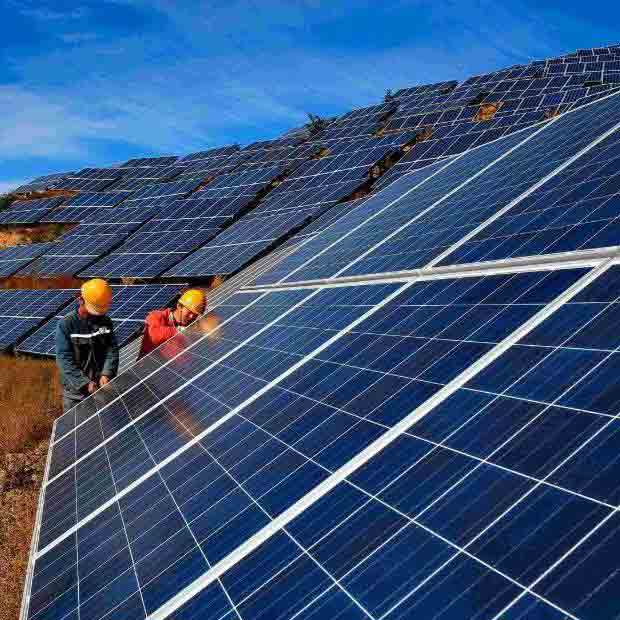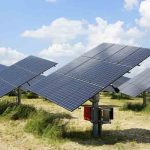
Maintenance of Solar Power Station
1. Maintenance of solar inverter
(1) The structure and electrical connection of the inverter should remain intact, there should be no rust, ash accumulation and other phenomena, the heat dissipation environment should be good, and there should be no large vibration and abnormal noise when the inverter is running.
(2) The warning sign on the inverter should be complete and undamaged.
(3) The function of the cooling fan of the module, reactor and transformer in the inverter should be normal according to the temperature, and the operation of the cooling fan should not have large vibration and abnormal noise, and if there is an abnormality, the power should be cut off and checked.
(4) Periodically disconnect the circuit breaker on the AC output side once, and the inverter should immediately stop feeding power to the grid.
(5) The temperature of the DC bus capacitor in the inverter is too high or exceeds the service life, and it should be replaced in time.
2. Maintenance of components and brackets
(1) The surface of photovoltaic modules should be kept clean, and dry or wet soft and clean cloth should be used to wipe photovoltaic modules, and it is strictly forbidden to use corrosive solvents or hard objects to wipe photovoltaic modules. The photovoltaic modules should be cleaned when the irradiance is lower than 200W/m2, and the liquid with a large temperature difference from the module should not be used to clean the components.
(2) PV modules should be checked regularly, and PV modules should be adjusted or replaced immediately if the following problems are found. PV modules have glass shards, burnt backsheets, and noticeable color changes. There are bubbles in the PV module that form a communication channel with the edge of the module or any circuit, and the PV module junction box is deformed, twisted, cracked or burned, and the terminal blocks cannot be well contacted.
(3) The live warning sign on the PV module shall not be lost.
(4) Using photovoltaic modules with metal frames, the frame and bracket should be well combined, the contact resistance between the two is not greater than 4 ohms, and the frame must be firmly grounded.
(5) Working under the condition of no shadow occlusion, under the condition that the solar irradiance is more than 500W/m?, and the wind speed is not more than 2m/s, the temperature difference on the outer surface of the same photovoltaic module is less than 20 °C. Photovoltaic power plants with an installed capacity greater than 50MWP should be equipped with infrared thermal imagers to detect the temperature difference on the outer surface of photovoltaic modules.
(6) Use a DC clamp ammeter to measure the input current of each photovoltaic module connected to the same DC combiner box under the condition that the solar radiation intensity is basically the same, and the deviation should not exceed 5 percentiles.
(7) All bolts, welds and bracket connections of the bracket should be firm and reliable, and the anti-corrosion coating on the surface should not crack and fall off, otherwise it should be brushed in time.
3. Maintenance of grid-connected distribution box
1) The distribution box shall not have deformation, rust, water leakage, and ash accumulation, the safety warning mark on the outer surface of the box should be complete and undamaged, and the waterproof lock on the box should be flexible in opening.
(2) Each terminal block in the distribution box should not be loose or rusty.
(3) The insulation resistance of the positive pole to ground and the negative pole to ground of the output bus bar should be greater than 2 megaohms.
(4) The connection between the DC interface of the distribution box and the combiner box should be stable and reliable.
(5) The connection between the DC input of the distribution box and the DC input of the grid-connected host should be stable and reliable.
(6) The DC circuit breaker of the distribution box should be flexible in action and the performance should be reliable and stable.
(7) The lightning protector configured on the output side of the bus bar should be effective
4. Connect cables and ground inspection between equipment
(1) The cable should not operate in an overloaded state, and the lead package of the cable should not appear swelling and cracking.
(2) The cable should be well plugged at the part of entering and exiting the equipment, and there should be no holes larger than 10mm, otherwise it should be blocked with fireproof mud.
(3) In the pressure of the cable on the equipment shell, the tension is too large, and the support of the cable should be intact.
(4) When inspecting the indoor cable open trench, it is necessary to prevent damage to the cable and ensure that the bracket is grounded and the heat dissipation in the trench is ensured.
(5) It must ensure that the equipment room is clean, dry and ventilated; Flammable and explosive materials are not allowed to be placed in the equipment room.
(6) Non-staff members cannot be allowed to operate the instrument, open the instrument, modify the parameters of the instrument, etc.





